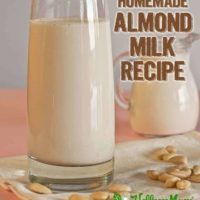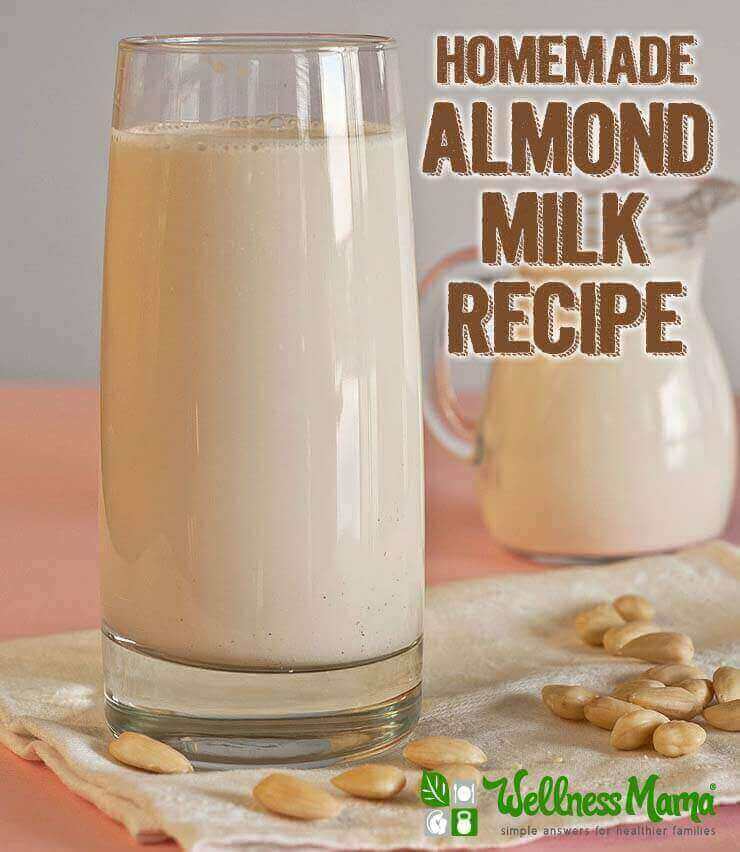Almond milk is a healthy and inexpensive alternative to conventional dairy that you can easily make at home! Statistics show that many people are choosing dairy-free milks and other products due to allergies, concerns about sourcing, or just taste preference.
Why Make Almond Milk?
Like virtually every other food or drink, almond milk is both less expensive and healthier when you make it yourself. While there are decent store bought brands available now, many brands contain additives like carrageenan to remain shelf stable and a keep a consistent texture.
Almond milk is a low glycemic alternative to rice milk, and doesn’t cause problems with hormone levels like soy milk does. It can be used in place of regular milk in recipes and baking. It is easy to make and has a light taste.
We used almond milk when we were working on reversing our son’s dairy intolerance and I still often use it (or homemade coconut milk) in recipes, coffee, or to drink simply because it is so inexpensive and easy to make.
If you are dairy free, making your own almond milk is a great way to save money and avoid additives. As a bonus, you can use the leftover almond pulp to make almond flour for use in recipes! If you are nut free as well, coconut milk is another good alternative.
If you go through a lot of almond milk in your home, I have found that it is much faster to use the Nutr Machine. While it can be pricey (use code WELLNESSMAMA10 for a discount), it can pay for itself very quickly if you use it often enough!
How to Store Homemade Almond Milk
This recipe lasts approximately 4 days in the refrigerator. Our family easily consumes this much almond milk in a few days, but if you won’t use this, it is best to reduce the recipe and make less to use as you need it.

Homemade Almond Milk Recipe
Servings
Ingredients
- 1 cup raw almonds
- 4 cups filtered water (plus more for soaking)
- 1 pinch sea salt
- ½ tsp vanilla extract (or ½ vanilla bean, scraped, optional)
- sweetener (such as 2 dates, 2 TBSP maple syrup, or a few drops of stevia, optional)
Instructions
- If desired, soak almonds for at least 12 hours in pure water with 1/2 tsp sea salt. This is an important step as it breaks down the phytic acid and enzyme inhibitors and cultures beneficial enzymes in the almonds. The longer the almonds soak, the creamier the finished milk will be. (Side note: soaking nuts should be done before eating them as well. Soak nuts in salt water for 12 hours, rinse them, and dry in oven on lowest heat. See tutorial here.)
- Drain the soaking water and rinse the almonds well. Do not keep this water to re-use as it contains phytic acid and is best to discard it.
- In blender or Vitamix combine almonds and pure water along with vanilla, sweeteners, or any other optional ingredients. See the notes below for some flavor suggestions.
- Blend 2-3 minutes until smooth and creamy. Mixture will expand some, so make sure your blender is not full before starting it.
- Strain mixture into a large bowl through a sprout bag, cheesecloth, or thin kitchen towel.
- Pour into glass jar or pitcher and store in refrigerator for up to four days.
Nutrition
Notes
Do you eat almonds? Ever used almond or coconut milk in place of regular milk? Tell me below!


Leave a Reply